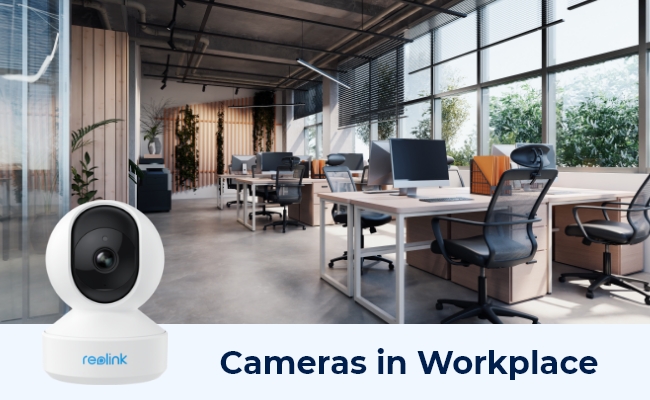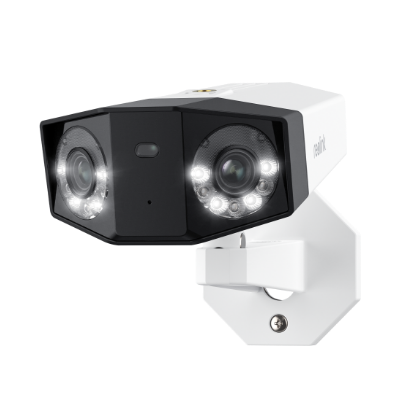

The use of video surveillance and security cameras in the workplace raises important questions about employee privacy. While cameras can improve security, deter crimes, and enable post-event investigations, they also risk intruding into workers' reasonable privacy expectations.
Laws and best practices exist to appropriately regulate camera usage, but tensions between security priorities and privacy protections remain inherent. In this article, we will discuss the key challenges involved in cameras in workplace.
Table of ContentsSecurity cameras, also known as video surveillance systems or CCTV (closed-circuit television), are commonly used in offices and workplaces for security purposes. They can help deter theft and other crimes, as well as assist in post-event investigations.
Some popular security camera types suitable for business use include:
For example, the Reolink Duo 3 PoE features two lenses with 16MP Super HD resolution.Other functionalities, such as night vision, smart motion detection to reduce false alerts, and easy remote access via mobile app - are suitable for many workplace surveillance needs.

Groundbreaking 16MP Dual-Lens PoE Camera
16MP UHD, Dual-Lens, Motion Track, 180° Wide Viewing Angle, Power over Ethernet, Color Night Vision.
The legality of workplace video surveillance with audio recording capabilities varies by state based on two-party consent laws.
In some states, cameras that also capture employee conversations and audio require permission from those filmed. This aims to protect private spoken communications against unauthorized recording.
However, other states allow cameras with audio in the workplace without permission under one-party consent laws if the recording party (i.e., the employer installing cameras) consents.
When security camera systems are installed in offices and employee work areas, certain employee rights come into play, which employers need to consider:
Employees have some reasonable expectations of privacy at work under federal and state laws despite not having an outright legal "right to privacy" in private workplaces. Still, overly intrusive monitoring can violate employee privacy rights, leading to legal issues for employers.
Laws generally require employers to disclose surveillance monitoring to employees through clear signage, memos, employee handbooks, or other written notifications. Lack of adequate notice about workplace cameras can breach employee rights.
Special legal provisions protect the privacy of employees' electronic communications like email, voicemail, internet activity, etc. Unauthorized access to such communications via cameras/monitoring may be illegal.
While employers own workplace surveillance footage, employees often have limited rights to access recordings if they wish to review or obtain copies, e.g., to support harassment complaints.
Laws and regulations surrounding video monitoring in US workplaces vary by state. While federal laws provide minimal employee protections, many states have additional laws employers must comply with when installing security cameras and conducting video surveillance. Moreover, each workplace has its own cameras in the workplace policy.
For example, some state laws on video surveillance in the workplace specify:
Despite video monitoring being generally permissible in offices and work areas, certain employee spaces are typically deemed private spheres exempt from employer surveillance. Restricting cameras in these sensitive locations aims to respect basic worker dignity, privacy rights, and personal freedoms.
Common workplace areas where security cameras are often prohibited include:
Filming restrooms or wash closets at work clearly breaches societal norms and lawful protections against sexual harassment. Surveillance measures scarcely justify the loss of privacy within necessary spaces for attending to personal needs.
Similarly, video recording in changing rooms and locker areas infringes on expected employee privacy while getting dressed on-site before/after shifts or exercise breaks.
During meals and breaks, workers have reasonable freedoms to casually congregate, speak openly, and remove professional public facades without judgment or monitoring. Thus preserving autonomy.
Patient privacy principles properly restrict unneeded surveillance of workplace medical aid/testing rooms. Health information sensitivities support limiting cameras in contexts involving vulnerability, care, diagnostics, etc.
Respecting religious/spiritual diversity may require camera-free rooms accommodating private rituals, ceremonies, worship, meditation, or reflection at work as suitable.
Overall, employee spaces serving clearly personal functions justify strong norms and often legal rights restricting unnecessary, unreasonable, and excessively intrusive video monitoring by employers.
When regulating workplace surveillance systems, properly balancing operational security needs against employee privacy rights is vital for avoiding overreach, violations, and litigation risks.
Best practices for appropriately balancing workplace video monitoring include:
Detail camera usage restrictions, access protocols, data retention rules, complaint mechanisms, and other specifics in formal privacy/surveillance policies. Outline monitoring principles rather than absolutes - human judgment is still required. The cameras in the workplace policy is a must-have for any business or workplace.
Clearly communicate surveillance policies through multiple official notices like handbook sections, on-boarding docs, prominent signage near cameras, etc. Ensure informed understanding of monitoring practices organization-wide.
Only install cameras serving defined security purposes in designated work areas based on risk assessments. Avoid blanket filming of all spaces or tasks. Use strict authorization processes for new cameras while encouraging input.
Explore built-in camera privacy filters, masking techniques, and smart redaction algorithms that automatically obscure screens, faces, or other sensitive visibility during filming as suitable.
Permit workers to formally review limited personal footage if requested, e.g., to support harassment or discrimination allegations. Honor access rights are legally entitled in some states.
Bar non-security redistribution of surveillance recordings outside formal investigations, e.g., via workplace social media or breakroom screens. Such barriers aid confidentiality and data dignity.
Generally, yes, as long as suitable notice about workplace surveillance systems is provided. Still, numerous location, disclosure, and usage restrictions apply per state laws and employee protections against overreach.
Likely not directly since monitoring shared offices/work areas itself is often legally permissible. Yet alarms about overly intrusive filming may indicate employer policy issues worth raising via formal complaint processes if available.
Yes, surveillance systems must be clearly visible or disclosed through signs and notices under most state laws. Concealed filming without notice flouts transparency rights that allow employees to understand monitoring practices impacting them.
Installing workplace video surveillance requires carefully respecting employee privacy rights alongside security priorities. Lawful monitoring supported by strong governance policies, transparency, and strategic practices allows employers and workers to jointly foster safe, dignified, and productive workspace built on trust.
What are your thoughts on balancing privacy and workplace surveillance systems? What camera usage guidelines seem sensible to propose for businesses? Please share any questions, examples, or advice in the comment section below! Let's discuss together!